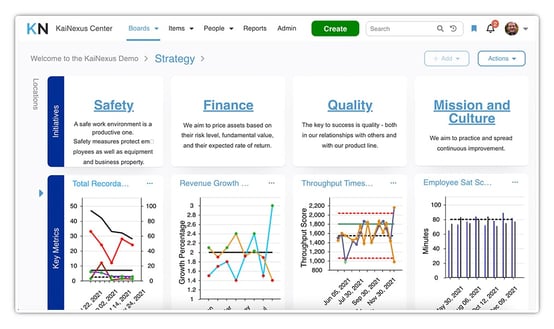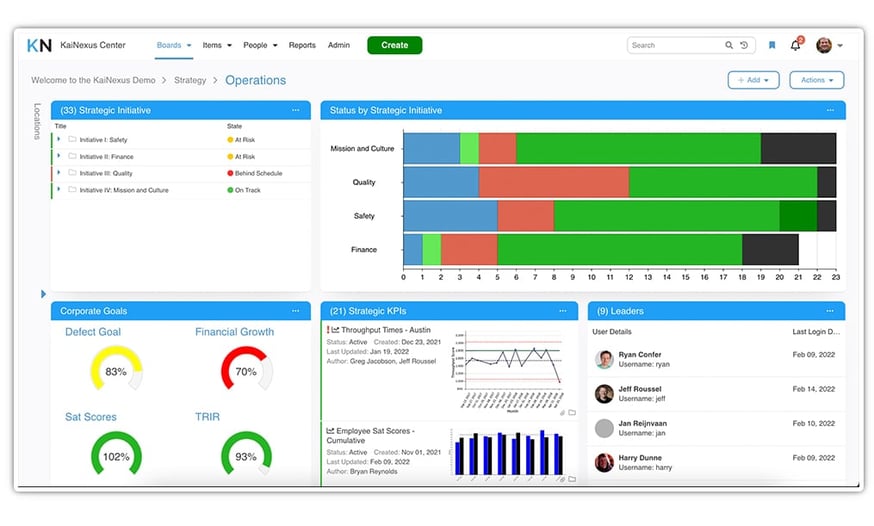
Strategy Deployment, also known as Hoshin Kanri, is a management methodology first popularized in Japan in the 1950s, based on the ideas of Professor Yoji Akao. Akao taught that "Each person is the expert in his or her own job, and Japanese TQC [Total Quality Control] is designed to use the collective thinking power of all employees to make their organization the best in its field."
Hoshin means "compass needle" or "direction," and Kanri means "management" or "control." This is an apt name, since the methodology is all about how an organization’s overarching strategic goals should guide action at every level of the business. The goal is to get everybody pointed in (and working toward) the same direction, often referred to as "true north."

It's critital to identify clear objectives, and then to communicate those objectives to every level of the organization. Doing so provides everyone from front line staff to senior leadership with a common vision and goal, necessary for sustaining motivation toward progress.
In order to understand how things can be improved, one must first have an understanding of the current state. Transparency into the current state gives a sense of direction and purpose to improvement work, as efforts are targeted toward improving your KPIs.


When there are a plethora of improvements to be made, it's important that senior leaders guide stakeholders to make objective, strategic decisions about what should be prioritized. Creating a custom weighted scoring system allows people at all levels of the organization to evaluate the complexity, risk, priority, etc. of any initiative based on predetermined criteria.
Improvements can be better targeted toward True North objectives when priorities and targets are clearly defined and shared.
A key component of Strategy Deployment is that the entire organization is engaged in achieving the True North objectives. By enabling everyone to contribute improvements to reach common goals, you are able to maximize the creative potential of the organization for more impactful results.

Focuses on five or fewer goals to ensure that there are sufficient resources available to meet each goal to ensure that only the most important facets of the business are included.
Identifies both evolutionary and revolutionary goals that will take the business to the next level if achieved. They may not be easy goals, but they’re worth the extra effort.
Identifies a person to own each goal, who will act should the efforts toward achieving it veer off track and to remove roadblocks along the way.
Outlines performance indicators that accurately track progress toward completion of the goals, without producing unintended negative consequences.
Goals are agreed upon by both the top- and mid-level management to create a shared sense of responsibility for achieving the goals, and provides fresh perspectives in the planning process.
KaiNexus accelerated change by engaging leadership with easy access to the info they need, and the ability to show their commitment and support.Matthew Cannistraro
KaiNexus has given us a transparent, central way to manage everything from daily improvement to strategy deployment.Jason Coons
KaiNexus empowers the people who directly impact outcomes. It may be the most powerful tool in the health care cultural revolution.Kristin Bentz

At a lower level, middle management is responsible for identifying steps and plans to ensure that their departments are working toward achieving the goals outlined in the strategic plan. Communication is important here, as it’s critical that mid-level management understand the goals and agree with the value of the key performance indicators. Monthly reviews can help managers hone their tactics, ensuring that they stay on track.
Supervisors and team leaders on the front line are to develop initiatives and projects that would improve their processes to implement the tactics outlined by the mid-level managers. Again, communication between leaders is key, so it’s important that those mid-level managers stay involved along the way.
As progress is made on the front lines, it’s important to report on the progress and results so that departmental tactics and operational details can be adjusted as needed. This creates an effective, closed-loop system that facilitates continuous improvement and the refinement of plans and measures over time.
One of the key elements of hoshin kanri is that the work is never done; the process is continuous, with the review of the previous year’s performance being the basis for the next year’s plan. Objectives that were successfully completed are analyzed to make sure that the implemented plan and performance measures were in fact the cause of the success. Those that were not met are analyzed to determine what went wrong, and come up with new steps for achieving success in the future.
Copyright © 2025
Privacy Policy